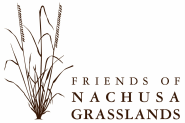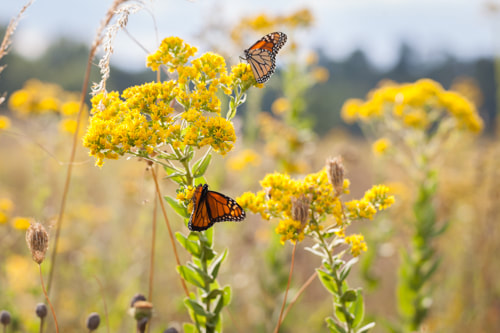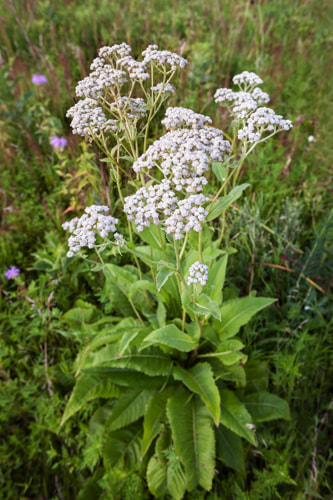Aster Family (Asteraceae)
Alternatively called the Composite Family
Click a link below to find out more about each plant in the Aster Family:
|
How can I recognize a member of the aster family?
Aster means star! Look at their flower structure. Nearly all species in this plant family have their flowers in dense flower heads, surrounded by rays that make it appear to be a single flower. The rays may look like petals, but are actually sterile (usually) florets lengthened through evolution to attract insects for pollination. The seeds usually have hairy structures that can be lifted by wind or stick to animal fur, aiding in dispersal. However, the seeds of some species in this family drop the hairs, such as in the sunflowers. |
Cool stuff to know about asters:
|
common yarrowAchillea millefolium
Ancient medicine! This common plant is native to the northern hemisphere. Native Americans and Europeans alike used it medicinally especially to help staunch bleeding, leading to its other nickname, woundwort. (Wort derives from Old English for plant and further back meant root.) We think yarrow comes from an ancient Anglo-Saxon word meaning “to repair.” The ferny looking leaves are delightfully soft. The foliage smell is strong, but pleasant to most people. Planted as a companion plant in a garden the odor seems to repel some insect pests while the flowers attract large numbers of pollinators. Yarrow can even be used to dye wool yarns naturally resulting in a green to yellow color. Scientific name origin In Greek, Achillea is from Achilles the warrior hero. Legend has it that Achilles used it to keep his armies healthy. The species name, millefolium, is Latin for thousand-leaved, referring to its many leaf parts. compass plantSilphium laciniatum
Fun Fact The leaves of the compass plant point in opposite directions, many times north and south. This iconic prairie plant was used by settlers crossing the prairies as a sort of compass to guide them. Deep roots! The compass plant can grow up to 10 feet tall, but that is just the tip of the iceberg! The main or tap root can reach a depth of up to 16 feet. Scientific name origin The genus name, Silphium, has a Greek origin and refers to the resinous juice that oozes from a stem if broken. From the Latin, lacinia, meaning a lappet or flap of a garment, referring to the lobed leaves. cup plantSilphium perfoliatum
Natural water cup Notice how the leaves of the cup plant are opposite each other and join together at the stem to form a ‘cup–like’ shape. Look inside the “cup”. Do you see any water in the depression at the base of the stem? Birds will often sip the water from this tiny pool. In one of the cup plant photos included, a tree frog has found the water by the stem and nestles in it. Hideout Where can wildlife find a place to rest and be concealed in the prairie? The cup plant can provide the perfect hideout. Although the plant is anchored by one deep central taproot, numerous shallow rhizomes surround the root and help spread the plant, often forming colonies of these tall giants. The forest of leaves creates a great hiding place for birds during the heat of the day! Scientific name origin The genus name, Silphium, has a Greek origin and refers to the resinous juice that oozes from a stem if broken. Perfoliatum in Latin means “ through the leaves”. grandpa hawkweedHieracium longipilum
A well behaved hawkweed Remember that “weed” in a common name does not necessarily mean the species is an unwanted non-native plant. This iconic sand prairie hawkweed grows single or only a few together unlike the weedy non-native hawkweeds which form solid carpets with their basal rosettes. Grandpa hawkweed has the longest hairs (up to an inch long!) and it’s the tallest of all the Hieraciums. The small yellow ray flower petals are strap-like with a fringe on the end. The tiny seeds have pretty tawny hairs that carry the seeds on the wind away from the parent plant. Scientific name origin Hieracium is from the Greek for “hawk”, from an ancient thought that hawks used the plant to help their eyesight; longipilum is from the Latin for “with long white hairs.” heath asterSymphyotrichum ericoides
Lives in colonies This aster is most often found in dry soils in full sun. It makes large colonies through root rhizomes underground. Like most “asters” these bloom in the autumn. Their numerous tiny flowers (yellow centers with white ray petals) attract a wide variety of insect pollinators. Young foliage is eaten by caterpillars, plant bugs, and mammalian herbivores. Scientific name origin Symphyotrichum is Greek for the junction of hairs, perhaps referring to the seed hairs attachment to one point. This is now the new name for New World asters after it was determined that they are genetically different enough from the Old World asters. Since those were first given the genus name “Aster” the New World asters had to take the second name ever used for them, this much long hard to pronounce name. Ericoides is from Latin, meaning ‘resembling heather’ due to the tiny needle-like green bracts on the flowering stems. old-field goldenrodSolidago nemoralis
Many in my family There are about 60 different types of goldenrod species in North America. You can tell me apart from all my siblings because I’m a late bloomer, a little shorter, and my flowers look like a wand. “Solidago nemoralis” sounds like a great spell! Rubber source In the 1920’s Henry Ford, and Harvey Firestone asked Thomas Edison to find an alternative source for rubber to make tires. Edison experimented with thousands of plants and eventually found a type of goldenrod plant that could be used to make rubber. Scientific name origin In Latin Solidago means "to make whole", as historically the goldenrods were used for healing; nemoralis means "of the groves", referring to one location where this plant can be found (though this goldenrod loves the sun and is found in Nachusa's prairies). pale purple coneflowerEchinacea pallida
One of Nachusa Grasslands most bountiful blooms. Some of our original unplowed remnant prairie have acres of this native. It also grows very well in our prairie restorations. There is one other of this genus in some parts of Illinois (Echinacea purpurea). Ours, pale purple coneflower, is the most widespread in Illinois. It is quite stiff and the stem and long leaves near the base are all covered in rough white hairs. Scientific name origin Echinacea is from the Greek, which means, like a sea urchin, because of the prickly seedhead. Pallida is Latin for pale, because it is usually paler than the other purple coneflowers. Sometimes there is even a white bloom. pasture thistleCirsium discolor
Thistles need a better public relations campaign The flowers are nectar for many pollinators, make a fine honey, and the blossoms are very fragrant. The entire plant can be eaten: leaves with spines removed are excellent salad or cooked greens. The stalk has been peeled and eaten raw or cooked. And the roasted root is said to be sweet. Goldfinches time their nesting (late in summer) to when thistles are in seed. The seed fluff is used by goldfinches to line the nest and the parents feed their nestlings regurgitated seeds. The spines protect the plant from grazers and even the flowers from ants which take nectar but don’t effectively pollinate. Each plant only lives two years. It takes two years for this thistle to bloom; the first year it just has a basal rosette of leaves. Scientific name origin Cirsium is Greek for swollen veins, which this plant was thought to cure. Discolor is Latin for two colors. prairie dock
Silphium terebinthinaceum
Deep roots How deep are the roots? The taproot can extend down 12 feet deep. Whew! This comes in very handy during a drought. The prairie dock has enormous spade-shaped leaves at the base of a (usually) extremely tall, leafless flowering stem. It is by far our tallest flower, sporting small sunflower-like flowers in late summer. Slow to establish, but once it has, it’s almost indestructible. How do you measure up to these giants of the prairie? Scientific name origin Silphium is a classical Greek name for a resinous plant, and these do produce a fragrant resin which was chewed like gum by Native Americans. Terebinthinaceum is Latin for turpentine-like. So, both names refer to the resinous nature of the plant. pussytoesAntennaria plantaginifolia
Cat’s paws on the prairie These fuzzy plants grow in colonies connected by underground runners. Sometimes each colony is either male or female. If a female flower fails to be fertilized it can still produce seed! Plants in this genus tolerate cold very well; many species are alpine. Perhaps those silvery white “hairs” all over keep the plant warm! The caterpillars of American painted lady butterflies depend on pussytoes (and related plants) for food and shelter (they roll up inside the leaves). Scientific name origin Antennaria, from the Latin for antennae, either because the resemblance to insect feelers of the hairs of the females flowers that split into two threads, or the hair on the seed that carry it on the wind. Plantaginifolia means the leaves are shaped like those of the plantain plants. |
rosinweedSilphium integrifolium
Chew on this fact: Rosinweed gets its name from the gummy resin inside the stems, which was used like chewing gum by Native Americans. This is the smallest of all the Silphiums. Native American uses Rosinweed was used by Native Americans for a variety of purposes. The Pawnees made tea from the pounded roots for what they called “general debility” or weakness. The Omahas used it in a treatment called “ashude-kithe” to alleviate the symptoms of a head cold. Scientific name origin The genus name, Silphium, has a Greek origin and refers to the resinous juice that oozes from a stem if broken. The species name integrifolium, means “whole leaf”. rough blazing starLiatris aspera
I love the sandy and gravelly soil places at Nachusa! Look for my amazing spike of pinkish-purple flower “buttons.” Bees, butterflies, hummingbirds and many others love my nectar and help move my pollen around so my baby seeds can develop and blow away in the wind. Nachusa has three kinds of blazing stars—me, a shorter one, and one that loves wetter soils. You have probably seen my cousins in flower arrangements because I am so pretty. Scientific name origin Liatris has no known derivation! The plant and language experts do not know what word means. Aspera means harsh in Latin. sawtooth sunflowerHelianthus grosseserratus
Easy identification There are at least eight species of sunflower native to the preserve that are very similar in appearance, and to add to that frustration, hybridizing among sunflower species is possible. However, sawtooth sunflower is easy to identify. It is Nachusa’s tallest sunflower, and the leaves usually have serrated edges, but the most distinguishing feature is its smooth reddish stem (often with a powdery white coating). Like other sunflowers its nectar and pollen are very important for bees and butterflies. Also other parts of the plant (leaves, stem pith, juices, and seeds) are food to many insects (caterpillars, flies, beetles, grasshoppers, aphids, and the sunflower spittlebug). The fat and protein content of the seeds are very important for birds and rodents to get through the winter lean times. Scientific name origin Helianthus is Greek, helios, meaning sun, and anthus, meaning flower. Grosseserratus is Latin meaning, with large sawteeth. showy goldenrodSolidago speciosa
Fun Fact I’m the most showy of all the goldenrod species. My reddish stalks can grow up to 4 feet tall and I have pyramid-like clusters of flowers that are especially attractive to butterflies. Scapegoat I often get the blame for people’s allergies, but ragweed, my Asteraceae cousin, is actually to blame. Scientific name origin In Latin Solidago means "to make whole", as historically the goldenrods were used for healing; speciosa is Latin for showy, a spectacle. stiff goldenrodOligoneuron rigidum
Latex rich Did you know Thomas Edison and others experimented with using goldenrods as a source of rubber? This is because some species are rich in latex. Medicinal uses Many goldenrod species were used as medicines before the modern age. Goldenrod does seem to act like a diuretic and in Europe is used in teas to flush out kidney stones and stop inflammatory diseases of the urinary tract. The genus for goldenrods used to be Solidago (to make whole) but recently stiff goldenrod and a few others were put in their own genus. It certainly looks a bit different with its fuzzy thick leaves, stem, and flower head. Scientific name origin Oligoneuron is Greek for few-nerved. Rigidum is Latin for stiff. tall coreopsisCoreopsis tripteris
I am not a sunflower even though I have yellow flowers, because I only have eight ray flowers. My one of my nicknames is tickseed. But my seed won’t stick to you. I love to wave in the breeze in mid-summer. I can handle a lot of different kinds of soil, from dry to wet and sunny to slightly shaded. My yellow ray flowers are usually eight in number and my inner disk flowers are reddish-brown. I am a smooth one and the tallest of Nachusa’s three species of coreopsis. I have lower leaves that are divided into 3-5 lance-shaped leaflets (2-5 inches long) and upper leaves that are not divided. Scientific name origin Coreopsis is Greek and means, the appearance of a bug, referring to the rounded flat seeds that might look like a tick to some. Tripteris is also Greek and means three-winged. tall goldenrodSolidago altissima
Some botanists consider this to be a variety of Canada goldenrod (Solidago canadensis). These two species are the most common goldenrods in our area. Due to their arial seed dispersal, deep roots, and unpalatability they persist in overgrazed pastures and abandoned fields. Goldenrods provide nectar and pollen to almost every imaginable insect and are especially important late in the season when fewer other flowers are blooming. Human use Humans have tried using preparations of a variety of goldenrods for remedies for sore throat, toothaches, wounds, and many other ailments. Some species have been used for cloth dyes and were tested for use as a rubber/latex substitute. Not a ragweed! People with hay fever often mistake goldenrod for ragweeds which bloom at the same time, but ragweeds have tiny green flowers that make them hardly noticed. The pollen of goldenrods is too large to bother the nose, whereas pollen of ragweed is tiny and light enough to be wind dispersed and irritates the nasal passages. Scientific name origin In Latin Solidago means “to make whole,” as historically the goldenrods were used for healing. Altissima is Latin for tallest. viscid grass-leaved goldenrodEuthamia gymnospermoides
Goldenrods are very common all over the USA (at least 90 species). They were even proposed as our national flower due to the idea that the many tiny flowers are needed to make a perfect whole. Goldenrod plants form clones so dense no other plants can get in. This short, flat-topped narrow-leaved species, with the long name is a welcome addition to the prairie, attracting many insect pollinators. Because goldenrods bloom at the same time as the non-showy ragweeds people confuse the two. Ragweed pollen is tiny and wind pollinated while goldenrod pollen is large and sticky and requires insects to move it around. Only the ragweed pollen annoys our noses. Scientific name origin Euthamia is Greek for well-crowded. For the species gymnospermoides, the suffix "oides" in Latin means it resembles, in this case a genus Gymnosperma. wild quinineParthenium integrifolium
A pollinator favorite! Also called American feverfew. However, there is no clinical evidence that this and related plants are effective as medical treatments. From late spring to mid-summer, the large flower cluster is bright white and resembles a loose cauliflower head. The thick stalk leads to a tap root with side rhizomes which grow sideways to produce more plants, therefore often occurring in large groups. These plants are 2-3 feet tall, so a large mass of these stout perennials are fun to walk through to admire their structure and the many pollinators and other insects that come to enjoy all parts of this plant. Scientific name origin Parthenium is Greek for ‘virgin’ and integrifolium is Latin for ‘entire-leaved’ (no lobes). However, the leaves are quite toothed, wavy, and have a thick, sandpapery texture. yellow coneflowerRatibida pinnata
Long & beautiful bloomer A beautiful common prairie wildflower that can grow in dry or medium moist soils in full or partial sun. The yellow ray petals droop, like a ballerina tutu. Many bees, wasps, butterflies, and beetles collect nectar and pollen from this long blooming composite. The caterpillar of the wavy-lined emerald moth camouflages its body with fragments of the flower while feeding. The seeds when crushed have a lovely citrus odor. American goldfinches have been seen eating the seeds in winter. Scientific name origin The genus was named by Constantine Samuel Rafinesque (1783-1840) who came to the Ohio Valley and collected and gave sometimes creative names to plants and animals. Ratibida might two equal clefts, however this is cryptic. Pinnata means a leaf with a central stem and small leaves arranged on both side of the stem. |



